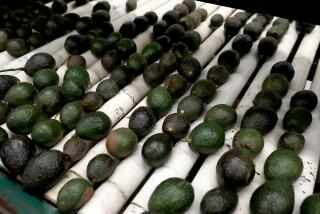Introducing . . . Buddha’s Hand
- Share via
Shoppers usually stop in their tracks, jaws hanging down, the first time they see a Buddha’s Hand citron, which looks like a cross between a lemon and a squid. Its ancestor, the ordinary citron, is one of the three original species of citrus and looks like a large, lumpy lemon; in the Buddha’s Hand, the fruit splits at the end opposite the stem into segments that look somewhat like human fingers - whence the fruit’s other name, fingered citron. This prodigy is a genetic mutation that arose many centuries ago somewhere in the citron’s homeland, southwestern China and northeastern India. (Occasionally similar-looking fruits will develop on a normal lemon tree, but these are caused by mite damage to the buds.)
The fruit is powerfully aromatic, with a characteristic aroma of violets or osmanthus. Its primary use here is ornamental, like a flower, and as a novelty, but the rind is also used to make jam and to flavor spirits. The variety of Buddha’s Hand found here is solid albedo (the white part beneath the rind) with no juicy pulp or seeds.
In China, at least half a dozen distinct types of Buddha’s Hand are grown, on several thousand acres. The trees are sold as ornamental bonsai pot plants, and the dried peel of immature fruits is prescribed as a tonic in traditional medicine.
Buddha’s Hand was imported to California and raised here in gardens starting in the late 19th century, but it is only in the last two decades that small-scale commercial orchards have been planted, about 25 acres across the state. The main season is late fall and early winter, but in coastal districts the trees produce fruit continuously.
Both Friend’s Ranch of Ojai and Bernard Ranches of Riverside bring Buddha’s Hand to the Hollywood and Santa Monica Wednesday markets. Small, scraggly examples can fetch just a few dollars, but the magnificent specimen depicted in the accompanying photo cost $20.
***
Here in Southern California, we’re lucky to be able to buy local avocados 12 months of the year, but finding high-quality fruit in autumn, during the transition between the old and new crops, is a bit of a challenge. The old crop of the dominant variety, Hass, is past its prime from all but the most coastal and northern growing areas; most of the avocados currently sold at supermarkets come from Chile, though their quality suffers from passing three weeks in cold storage during shipment.
For the new California crop, from flowers that bloomed in spring 2009, most commercial varieties are so low in oil content that the California Avocado Commission does not yet allow growers, including farmers market vendors, to sell them. Only the largest fruits of the Bacon variety are currently legal to sell, and even they are not yet at their finest.
One of the best options is to look for new-crop California-grown avocados of the Mexican type, which mature in fall and are distinctive in both appearance and flavor: They tend to be small with glossy, purple-black skin (so thin that it’s edible) and spicy, anise-flavored pulp. Varieties such as Mexicola and Topa Topa have long been used for rootstock because their seedlings are vigorous, relatively uniform, and cold-hardy. Because of their thin skins, the fruits are too delicate to ship commercially, but they’re well-suited to sale at farmers markets. It’s worth looking for the fresh and dried leaves, also anise-scented, which are used to flavor barbecued meats in Mexican cooking.
Mary and Cecilio Marquez of Rancho Santa Cecilia, from Carpinteria, sell Mexican-type avocados at the Burbank, Encino, Hollywood and Venice markets. Frank and Keiko Wells of Westfield Farms, from Camarillo, sell Walter Hole, similar to Mexicola, at the Beverly Hills, Thousand Oaks and Camarillo markets. Laura Ramirez of Loma Linda will sell Walter Hole starting Nov. 4 at the Hollywood, Santa Monica Wednesday and Saturday (Organic) markets.
More to Read
Eat your way across L.A.
Get our weekly Tasting Notes newsletter for reviews, news and more.
You may occasionally receive promotional content from the Los Angeles Times.










